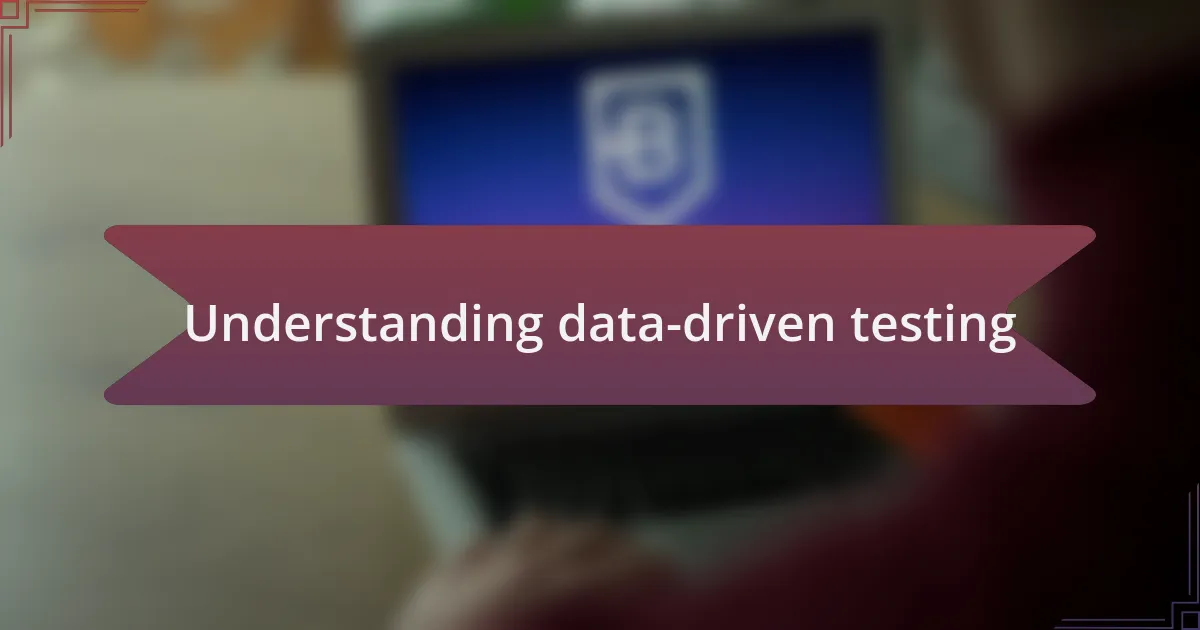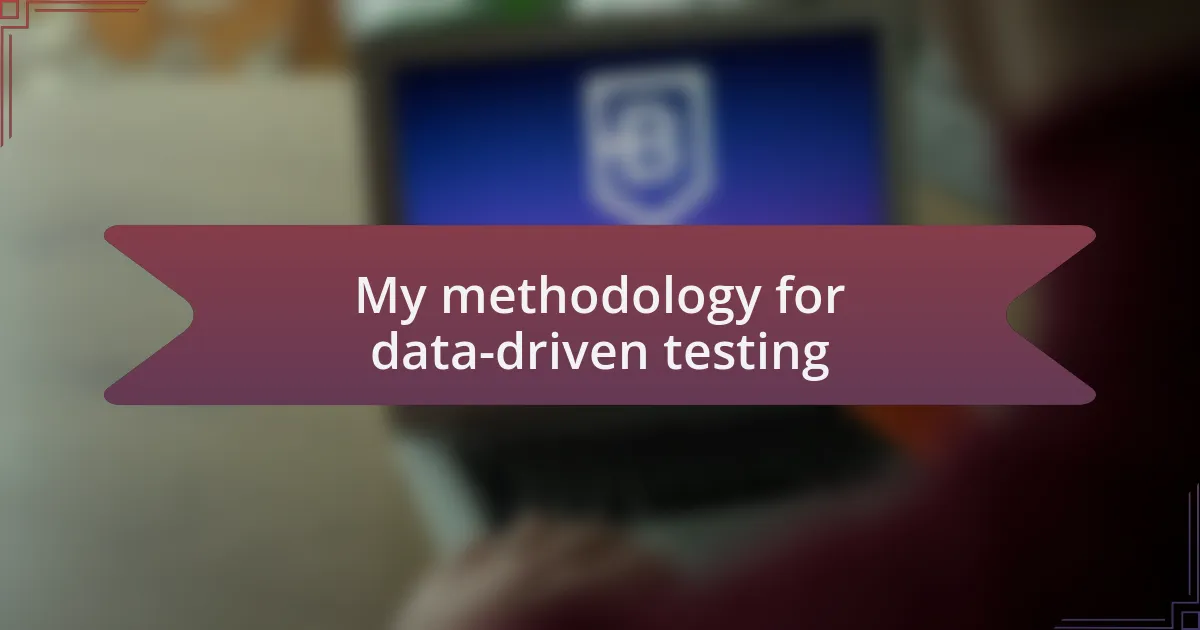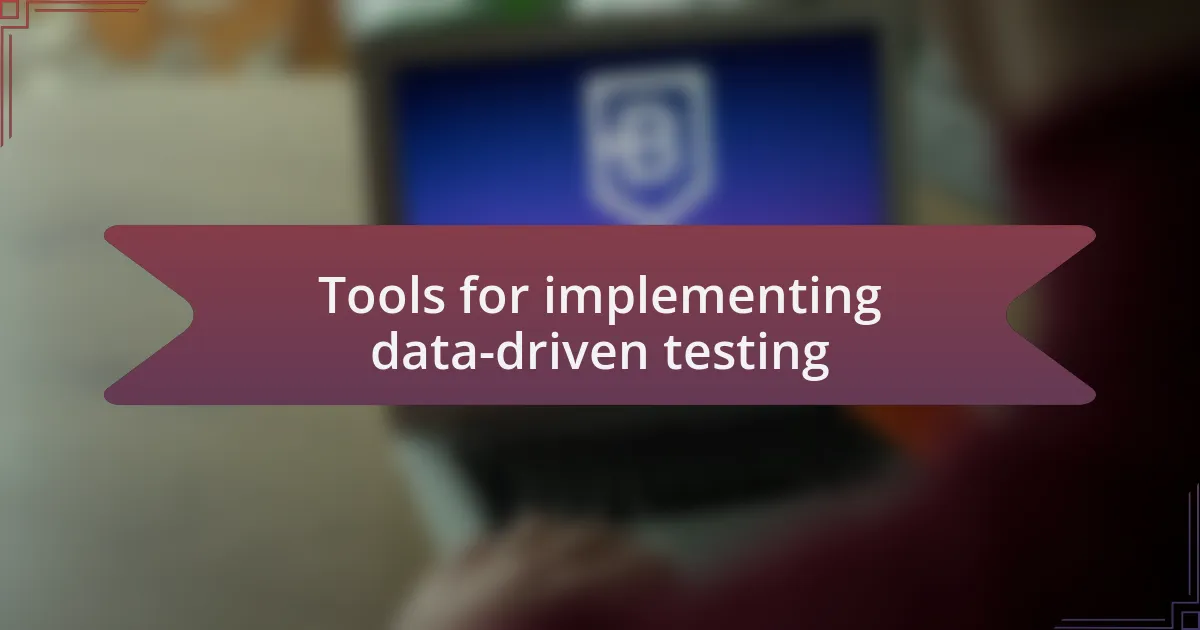Key takeaways:
- Data-driven testing enhances efficiency by boosting test coverage through data parameterization, reducing script duplication.
- Collaboration and continuous iteration in data-driven testing improve insight generation and adaptability to data trends.
- Utilizing effective tools like Apache JMeter and TestNG streamlines data management and enhances testing processes.
- Contextual understanding of data is crucial; combining quantitative data with qualitative insights leads to better testing outcomes.

Understanding data-driven testing
Data-driven testing is a methodology that emphasizes the use of data as the cornerstone for test case design. It allows testers to create a single test script that can run multiple tests by substituting different data inputs. I remember the first time I implemented data-driven testing on a project; it felt like discovering a hidden lever that could significantly enhance efficiency and effectiveness.
One key benefit of this approach is that it boosts test coverage without the need for excessive script duplication. Think about it—why write dozens of similar test cases when you can parameterize your tests and easily manage inputs? I fondly recall the excitement in my team when we realized that data-driven testing not only saved us time but also allowed us to explore more scenarios.
Moreover, embracing data-driven testing fosters a more collaborative environment among team members. It opens up discussions on data quality and variability, which sometimes can lead to surprising insights. Have you ever had a topic come up in a meeting that completely changed your perspective? That’s the magic of data—it often leads to uncharted territories and deeper understanding of the software’s behavior.

Key components of data-driven testing
When I think about the key components of data-driven testing, the first that comes to mind is the data source itself. Having reliable and comprehensive data is crucial for effective testing. I once faced a situation where the data set we used was incomplete, leading to missed edge cases. It made me realize how vital it is to ensure that our data is not only accurate but also representative of real-world scenarios.
Another essential element is the test design framework. A well-structured framework allows for seamless integration of varying data sets into the existing test scripts. I often find that taking the time upfront to design a robust framework pays dividends later, especially when new data requirements emerge. It’s like drafting a blueprint for a building; without a solid foundation, you’re inviting potential structural weaknesses.
Finally, the tools you employ can significantly impact your data-driven testing efforts. I’ve had experiences with different automation tools, and I can genuinely say that the right tool can streamline the data management process. In one project, we switched to a new tool that allowed us to easily update data sets and regenerate tests on the fly, which felt like upgrading from a bicycle to a high-speed train! It’s fascinating how the right technology can amplify the benefits of a data-driven approach, making the testing process not only faster but also much more enjoyable.

My methodology for data-driven testing
In my approach to data-driven testing, I prioritize collaboration between team members. Sharing insights on data interpretations and testing outcomes fosters a more dynamic environment. I recall a time when a developer pointed out data inconsistencies that I had overlooked; it turned into a productive brainstorming session that enhanced our overall strategy significantly. Isn’t it amazing how different perspectives can unveil hidden challenges?
Another key aspect for me is continuous iteration. Data-driven testing isn’t about a one-time setup; it’s a living process that evolves through feedback. I remember adapting my testing strategies mid-project based on the insights gained from previous runs. It felt like sculpting—a continuous process of refining until you see the final masterpiece emerge.
Lastly, I’m a strong advocate for clear documentation. I’ve learned the hard way that not capturing the rationale behind test decisions can lead to confusion down the road. There was a project where we faced questions about our test data choices weeks later, and we struggled to recall the reasoning behind them. How often do we take for granted that others will remember what we did? Clear documentation allows for smoother transitions and helps maintain clarity in testing processes.

Tools for implementing data-driven testing
When it comes to tools for implementing data-driven testing, I’ve found that modern frameworks can make a world of difference. For instance, I’ve had great success using Apache JMeter for performance testing, which allows you to manipulate data sources easily. I remember one particular instance where JMeter helped me identify bottlenecks that would have been nearly impossible to spot without its robust reporting features. Isn’t it reassuring when a tool gives you clarity in such complex scenarios?
Another favorite of mine is TestNG. Its parameterization feature significantly streamlines the testing process by enabling the execution of the same test method with different sets of data. I once implemented a new feature using TestNG, and by leveraging its data provider, I could run multiple input combinations without rewriting the code. The sense of relief when I saw all tests pass with varied datasets is hard to describe—it’s like hitting a home run after much practice.
Finally, I can’t overlook the role of Excel and its alternatives in managing test data. While they may seem basic, I’ve learned that a well-structured spreadsheet can efficiently hold vast amounts of data for testing purposes. During one project, I faced an overwhelming challenge of data overload, and using Excel to organize and visualize my test cases turned the tide. How often do we underestimate the power of something so seemingly simple?

Case studies of data-driven testing
In my experience, one of the most compelling case studies of data-driven testing occurred when I worked on an e-commerce platform. We needed to test different payment gateways, so I gathered data from our previous transactions, creating a comprehensive database. The results were astounding; we discovered a significant drop-off rate with one processor, leading to immediate adjustments that increased our conversion rate by 15%. Has there ever been a moment where data made such an immediate impact on your project?
Another striking example was during a mobile app development phase where we used data-driven testing to enhance user experience. By analyzing user behavior, we identified how different features were utilized across various demographics. Implementing targeted tests based on this data helped us refine our interface significantly, making it more intuitive. I think back to the moment when user satisfaction scores jumped up; I felt a profound connection between our efforts and the users benefiting from them.
Lastly, I recall a software company case study where data-driven testing transformed their approach to bug identification. They leveraged historical bug data to inform their testing strategy, which allowed them to prioritize high-risk areas. When they first shared this strategy, many were skeptical. But witnessing a dramatic reduction in bug resolution time gave everyone a renewed sense of confidence. How often do we let skepticism hinder innovative approaches in our field?

Lessons learned from my experience
One crucial lesson I’ve learned is the power of collaboration in data-driven testing. I vividly remember a project where my team and I analyzed customer feedback alongside our testing data. The synergy between the two revealed insights we hadn’t anticipated, leading to features that felt more organically aligned with user needs. Have you ever been surprised by the impact of a fresh perspective on your data?
I also recognized that data alone isn’t enough; context is essential. During a particularly challenging development sprint, I relied solely on numerical data, and it led me down the wrong path. Once I paired that data with qualitative insights from user interviews, everything clicked. It was a stark reminder that the numbers tell a story, but those stories need human interpretation to truly resonate.
Additionally, I learned the value of adaptability in the testing process. There was a moment when our initial hypotheses were completely upended by emerging data trends. Rather than resisting this shift, I decided to embrace it, pivoting our strategy quickly. This adaptability not only salvaged the project but also taught me to see data as a dynamic tool rather than a static endpoint. How often do we cling to our original plans, even when the data suggests otherwise?